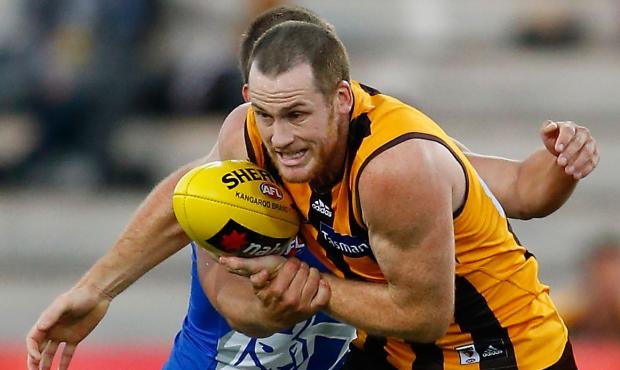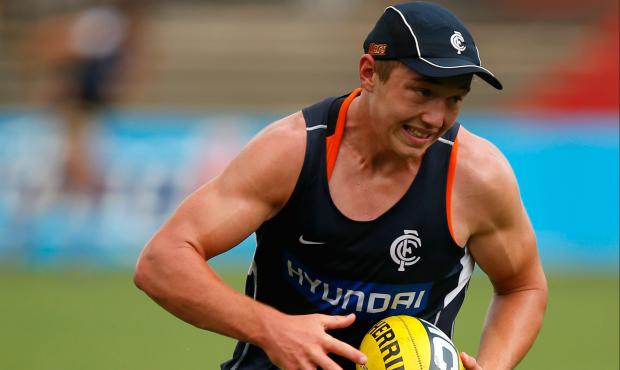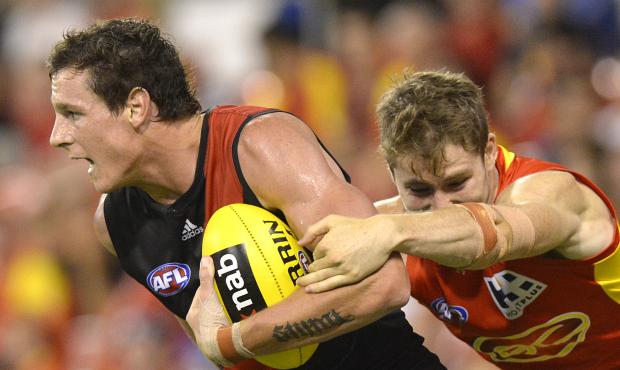Nathan Buckley's Magpies are still, in a sense, finding their own style. Last year the Pies, in Buckley's second season in charge, took a slightly cavalier approach when they had the ball. Their game-plan was built on short, accurate kicks and relied on the midfielders and running half-back flankers to link up and create. Buckley came to the conclusion that this style was exposing the team's last line of defence far too much. With some new personnel, Collingwood had a clear focus on improving its transition running during the pre-season. Finding the right balance between attack and defence is something Buckley will continue to strive for.
The Dockers' defensive structure is the key to Ross Lyon's game plan. They went to another level with their pressure and team defence in 2013, conceding an average of just 70 points per game. That pressure has been largely absent in the NAB Challenge but will undoubtedly be unleashed on Collingwood in round one.
He has made some adjustments at stoppages but the most notable adjustment in the clash against the Western Bulldogs was the swift, direct ball movement from kick outs. The Dockers were extremely damaging going coast to coast and a lot more adventurous in their ball use through the middle. That may be one aspect of their improved offence this year to keep an eye on.
Geelong
The Cats love to attack (they recorded the second-highest 'points for' tally in 2013) and there should be plenty more of that this year, even though the club is will have to do without key forward Nathan Vardy for the whole year and speedy half-forward Steven Motlop for the first part of the season. Attacking through the middle of the ground has been a Geelong speciality for a number of years, although the club continues to tinker with its handball to kick ratio. Last year the Cats employed a very effective forward press, winning more intercepts forward of the centre than any other team. - Adam McNicol
Gold Coast
During its first three years in the League, Guy McKenna has tried to base the Gold Coast game around winning the contested ball. With natural ball-hunters like David Swallow, Dion Prestia and Gary Ablett in the midfield, that hasn't been a problem, but this year they will look to spread from the contest a lot better with Harley Bennell, Jack Martin and Jarrod Harbrow used as exit men on the outside of the contest. The Suns like the idea of three genuine tall marking forwards and will continue to pump the ball long to those targets, knowing they have the likes of Brandon Matera at their feet if the ball comes to ground. - Michael Whiting
Greater Western Sydney
Throughout their short existence, the Giants have focused on contested football, despite their under-developed list. They want to win the hard ball and spread before moving it into the forward line. Even though
Jeremy Cameron was a key weapon last year, coach Leon Cameron wants an even spread of goalkicking options, using a mix of talls and smalls.
- James DampneyHawthorn
The Hawks appear well prepared for life after Lance Franklin having greatly reduced their reliance on the two-time Coleman medallist last year. Jarryd Roughead should again be Hawthorn's primary target in attack this season, but the Hawks will direct their fair share of attacks through Jack Gunston and David Hale. The Hawks' foot skills are the best in the competition and they have long relied on precision short passing to cut through opposition zones. That game plan stood up well in last year's finals series so look out for more of the same this year. - Nick Bowen
Jarryd Roughead will be Hawthorn's main man this year after Lance Franklin's departure. Picture: AFL Media
Melbourne
Its high possession style showcased in the first NAB Challenge game against Richmond was a massive turnaround from the past two seasons. Ten Melbourne players had 20 disposals and the Demons had 180 more possessions than Richmond. Once its key forwards – Mitch Clark and Chris Dawes – return to the fray, longer kicks forward of centre are expected but right now quick hands in close before releasing an outside runner in space will be the order of the day under new coach Paul Roos. - Peter Ryan
North Melbourne
The Roos reinvented themselves last season. Gone was the heavy reliance on handball and run and carry that defined their 2012 season, as they switched to a more patient game plan based on maintaining possession with short passes. The Roos held possession of the ball 5.3 per cent longer in games than their opponents in 2013, ranked No. 1 in the competition. North's style change did not affect its ability to score, as it was the third highest scoring team in the competition for the second consecutive year. The Roos will look to add a steelier defensive edge in 2014, having placed a heavy emphasis on tackling this pre-season.
- Nick BowenPort Adelaide
Coach Ken Hinkley immediately installed a defensive mindset at the Power after his appointment and it was a game-plan that took his side to great heights in 2013. Throughout this pre-season Hinkley has stood firm that Port's philosophy wouldn't change from last year, meaning the side's No.1 focus will be defence this season. While that will mean plenty of stoppages, the Power deliberately targeted outside speed last October to boost their ability to spread from said contests. The arrival of Jared Polec and Matt White looks like it will pay huge dividends in 2014,
with Polec in particular shining in the NAB Challenge.
- Harry ThringRichmond
It's been hard to get a grasp on Richmond's style given who hasn't played this pre-season but if we've learnt anything from Damien Hardwick so far, their plan will have a contested focus. Dustin Martin has been used off half back in a bid to give them more drive while Trent Cotchin and Chris Newman have bobbed up in attack, with
the captain booting four goals against Collingwood and the ex-skipper two against Melbourne. Shaun Hampson will allow Tyrone Vickery to stay in the forward line more often to partner Jack Riewoldt, and will rest there himself when Ivan Maric is ready to play post-ankle surgery.
- Jennifer Phelan
St Kilda
New coach Alan Richardson spent 2013 as director of coaching at Port Adelaide, and there will be similarities between the Saints and Power this year. Port was quick to move the ball out of its back half last season, and expect St Kilda to be similarly aggressive in its ball movement. The priority under Richardson, however, will be a strong defensive game and an ability to force turnovers through pressure. The new coach has worked extensively on the Saints' culture and work-rate since arriving. He is building strong players and will place a premium on contested ball.
– Nathan SchmookSydney Swans
The Swans' game-plan continues to evolve under John Longmire, but it always starts with hard, contested football. They then like to use chains of quick handballs to break congestion. They have the option of quickly kicking long to their tall marking options, but prefer to take their time to pick out a target. The Swans also use the pace of Lewis Jetta and Gary Rohan to get in behind the opposition and break the lines. - James Dampney
West Coast
Ball movement will be the biggest key for Adam Simpson's Eagles this year. John Worsfold relied on his team winning clearances, kicking long and winning one-on-one contests. Simpson will build from that foundation but has drilled his team all summer on taking first options by foot, lowering the eyes, moving the ball quickly and decisively. He has been critical of his players taking their time getting back off the mark at training. The Eagles won't allow teams to set up solid defensive structures against them. On the defensive end, the Eagles will likely try and float a spare defender across half-back at times and use him as a quarterback-style player.
Xavier Ellis did it to perfection against Fremantle. Elliot Yeo and Shannon Hurn will also be capable of filling the role. Opponents will need to weigh up their match-ups and decide whether to allow the 'plus-one' freedom or man them up and play a seven-man forward structure.
- Alex Malcolm





